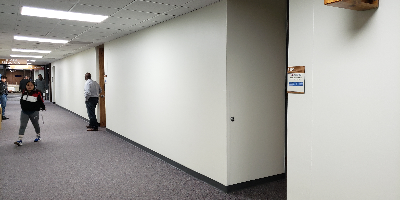sep 7, 1863 - Construction on the Kansas to Pacific Route
Description:
On Monday September 7, 1863 a ceremony was held to drive a marker at the river front near 5th and Minnesota in Wyandott to commemorate the start of construction on the Kansas to Pacific Route by the Union Pacific Railway – Eastern Division. There was a contest to see would drive the marking post. Hallett gave directions to cut a swath of trees 50 feet on either side of the proposed route. Wyandotte notables Silas Armstrong and A.B. Bartlett were asked to each cut one tree. It was reported that both trees landed at the same time. A railroad construction foreman was given the honor of driving the post. The marker was planted at the water’s edge with the western face challenging Missouri with the word ‘Slave’ and whose eastern face greeted Kansas with the word ‘Freedom’ (Coppin p. 15). Hundreds of citizens who arrived periodically and went down to the foot of the Kaw River in carriages, found hundreds of men cutting an opening through the woods south of Armstrong. The value of property in the area immediately shot up 100% (Morgan, p. 451). Hallett’s Company construction business opened an office at 5th and Minnesota for his brother’s John, and Thomas Hallett, who were chief assistants.On September 19, 1863 the editor of the Wyandotte Commercial Gazette wrote that Hallett’s Company had excavating machines that were capable of doing the work of one hundred men. The company had fifteen of these machines ordered and by September 26th the Gazette reported three miles of grading were finished (Kansas Historical Society, p. 165).
The rail line began at the Kaw River near the levee at Kaw Point. The first bit of rail and the first work train was delivered by steam boat. It was a wood burning engine originating in Virginia called the Wyandotte (L. Taylor, V, VII. p. 467). John Hallett, Sam’s brother, mounted the cab of the engine and held the throttle on the trial run. The track ended close to the river and the inexperienced engineer plunged the engine headfirst into the river. It was several days before the engine was extricated but the misfortune did not deter enthusiasm for railroading in Wyandott City. It was reported in the Wyandotte Commercial Gazette on December 26, 1863 that “within a few months the civilizer the iron horse would be puffing up the Kaw Valley.”
By November, forty miles of grading were completed along the Kaw River to Lawrence. A final load of rail and ties became ice bound on a Missouri River ferry in November and wasn’t delivered until February 1864.
A pontoon bridge was built to cross the Kaw River from Kansas City, Missouri at roughly the same place as the InterCity (Automotive) Viaduct today which is now called the Lewis and Clark Bridge (Taylor, 467). This same pontoon bridge was crossed by Union troops to enter the battle of Westport during Confederate Major General Sterling Price’s last raid in Missouri. The bridge lasted only a few months due to a rise in the river.
Added to timeline:
Date:
sep 7, 1863
Now
~ 162 years ago
